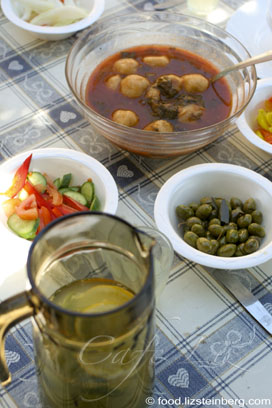Food and fresh air in the Judean hills

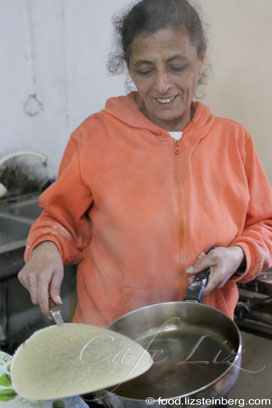
Sometimes us city folk want a little bit of country. It’s not like the countryside is all that far away, but given how long it takes us to plan a trip out of the city, you’d think this were a trip abroad.
Even for a strong incentive such as good food — it took us more than a year to get organized and attend the Mateh Yehuda regional food festival. In other words, we missed last year’s festival, but this year, after a few weeks of collective planning, we pulled ourselves together, picked six sites and organized a day visiting the home cooks, dairies and boutique wineries of the Jerusalem hills.
Calling it a food festival is a bit of a misnomer, even if that’s what it calls itself. While it does include a few organized events, the bulk of the “festival” is a pamphlet by the regional authority listing contact information for dozens of small food establishments. Many are actually individuals who offer home hospitality, hosting traditional ethnic meals in citrus-tree lined yards in the area’s various small towns.
Many of the towns in the area are not particularly well-off — many of the residents of the Ela valley villages, for example, are long-time immigrants from countries around the Middle East, such as Morocco and Iraq, who have been living there since they immigrated 50 years ago. The homes are not luxurious — but the flip side is that most everyone has plenty of land for fruit trees, goats and an expansive yard for hosting visitors. Furthermore, many of the towns are not the most accessible: While no more than a 45-minute drive from Tel Aviv and 30 minutes from Jerusalem, many are connected to the outside world by only 3 to 4 buses a day. You really need a car to get around here.

Our first stop was the Dagan bakery (050-637-4732) in the town of Tarum, on the Judea plain. There, on an olive-tree lined residential street amid beautiful green hills, Shulie Dagan bakes and sells Yemenite breads out of a home basement (top photo, right). The bakery was not well marked, and we entered hesitantly — we were the only visitors there. Shulie greeted us warmly with tastes of her flatbreads — puffy pitas and bubbly lahoh — alongside airy, lemony hilbeh and salty green, clove-infused skhug.
Shulie’s lahoh are different from those you’d find in Tel Aviv’s Yemenite quarter — they’re much heavier and thicker. She makes them this way because she believes paying customers should get their money’s worth, she said. As lahoh after perfect lahoh came out of her spotless aluminum pans, she explained her secrets — she doesn’t use teflon, she wipes her pans with a bit of margarine to prevent sticking, and she adds a porridge of precooked flour and water to her batter to give it nice bubbles, she said.
Indeed — look at those beautiful bubbles forming as the lahoh cooks.
She admitted that she wasn’t that interested in participating in the festival, and said the organizers pushed her to do so; anyway, most of her business is selling breads to establishments in neighboring communities, not necessarily drop-in customers like us. But that didn’t stop her from pushing us to taste treat after treat and inviting us back to learn her lahoh making process from start to finish.
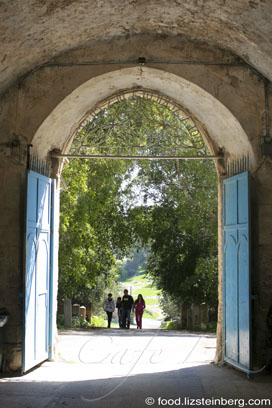

After our lovely time with Shulie, we headed south toward the sunny, shadeless Ela valley, making a quick pit stop at the Beit Jamal monastery near Beit Shemesh. The monastery, set amid scenic forests and hills, is not actually part of the festival. Its resident nuns and monks sell their own olive oil, honey and intricately detailed ceramics.

Further south is the village of Luzit and the Mozalis dairy (054-479-1356). The small farm, run by the Buie family, sells goat and sheep cheeses, produced from the milk of animals raised in a bucolic dream. The family also offers cheese-making workshops. The children of Americans originally from Mississipi, the Buie sisters grew up in Dimona and speak perfect English. (For more: A profile about the Buie family and their farm.)
When we arrived, Naomi Buie was cooking for the sabbath. The kitchen was full of home-baked breads for sale and fresh vegetables, including wild asparagus picked from the grazing fields — beautiful green shoots with a sweeter, more lemony flavor than their cultivated cousins. Naomi’s sister Bathsheva was leading visitors through the green, shadeless hillsides, where two other sisters tended the flocks.
Bathsheva explained that she milks the animals by hand — 30 animals a day, which takes an hour or an hour and a half, and gives her about 25 liters of milk. She adjusts her milking based on how much cheese she thinks she’ll be selling. The dairy products are all seasonal — the goats are milked for 8 months out of the year, the sheep for 2 months, and there’s no milk at all during peak summer, despite demand.

The resulting cheeses — we tried a soft goat tsfatit, a lightly salty sheep Bulgarian cheese and a labaneh-style spread — are rich and creamy, with only a hint of the flavors that characterize goat and sheep cheese. A lemon pie made from sheep milk was equally rich and creamy, with no hint of sheep flavor.
The cheeses are sold exclusively out of the family’s home, and given the natural production process, it’s no wonder that demand is high — half the cheese varieties were sold out when we arrived. (Example price: 25 shekels for a block of tsfatit.)

Ben and Bathsheva discuss vegetable farming; Sarah photographs a goat.
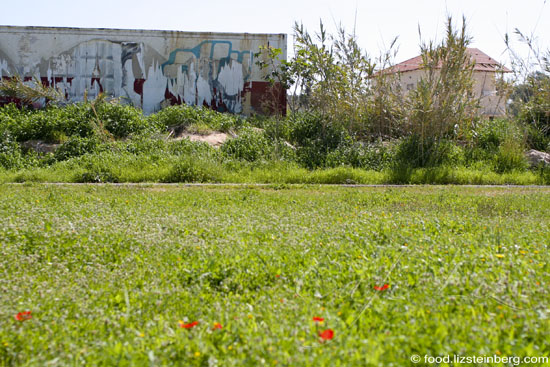
Lunch was at the neighboring village of Agur, with Sarah’s relative Osnat (050-751-0561 or 02-991-2868). Osnat hosts groups for traditional Kurdish cooking. She was swamped when we arrived — groups of people filled half a dozen tables arranged in her yard and living room, and they kept coming. We got a small table under a lemon tree.

The first dish was kubbeh in a tomato-based broth full of vegetables (photo, top left), including kardi (arum), a traditional, foraged green that is poisonous unless cooked properly (for hours, with lots of lemon to neutralize the poison). I thought I could taste a slight tingling from the arum, but Sarah said that after such a long cooking time, it didn’t have much flavor left and was there mostly in the name of tradition. (For more: Sarah’s story about Osnat and kardi.)
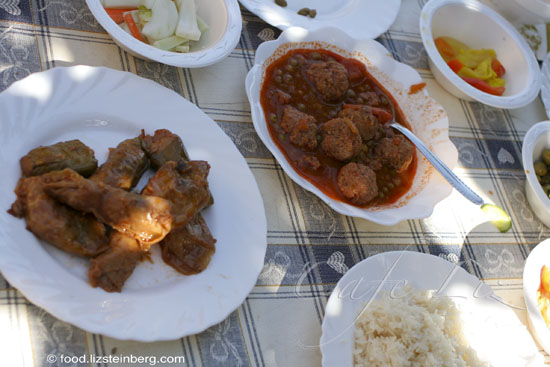
Alongside large pitchers of lemon-verbena infused lemonade, Osnat also served us a lovely mix of little stuffed vegetables — cabbage, squash and onion — which had a rich caramel flavor because the stuffed onions were arranged at the bottom of the pot. In case it’s not entirely clear — all this food is incredibly labor intensive, since each bite-sized kubbeh or stuffed vegetable is individually prepared by hand. (At left in the photo above — not the most photogenic, but good.)
Osnat didn’t have time to talk with us, but Sarah explained that her foods contained more paprika than most Kurdish cooking because her family was from the village of Homs (in northern Iraq, not Syria), which is close to the Turkish border.
Afterward, we wandered through her yard, photographing things like these old scales-cum-garden ornaments:
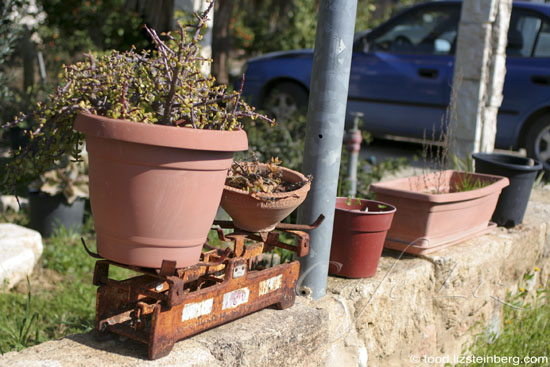

Just outside the village is the Agur winery (054-475-9672), which also had a steady flow of people. The winery, which produces 30,000 bottles of wine a year, does not grow all its own grapes, but it gets them exclusively from vineyards in the Judean hills. For those with fine enough palates, these wines are a chance to experience the terroir; for the rest of us, they’re simply good tasting wines.
The winery staff was offering tastings of three different wines — a white, the Blanca 2010 (one of my favorites from the 2011 wine expo), and two reds made from precisely the same blend of grapes, the Kesem 2010 and the Special Reserve 2009. Bottles sell for between 70 and 130 shekels.
I loved the rustic decor inside. I’m sure the mid-afternoon sun contributed to the effect:
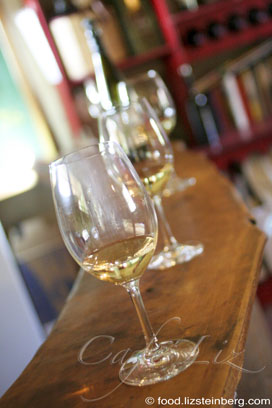


Outside, people drank wine near the processing facilities.

Our final stop for the day was supposed to be the Tzuk dairy (054-523-9117), which sells a lovely range of goat cheeses including a soft charcoal-coated cheese and an excellent camembert. But — if I haven’t already hinted this — the festival isn’t the most organized, and despite being listed as open, the dairy shop was closed when we arrived. The only souls on the premises were lots of goats and their two caretakers — and a decent number of visitors like us. (For more: Sarah reviews dairies in the area, including Tzuk.)


The Tzuk dairy, and a wild asparagus shoot growing in a nearby field.
After a few calls to the owners, one of the goat caretakers let all the visitors into the closed shop and told us to take the cheeses out of the fridge to taste them. We’d come all that way, so we wanted to buy cheeses too — the farm has a long, deeply pitted access road, partially blocked with several fallen trees — but for some reason, the owners said that wasn’t possible. We’d have to be content with tasting — for free.
A slightly strange end to a lovely day.
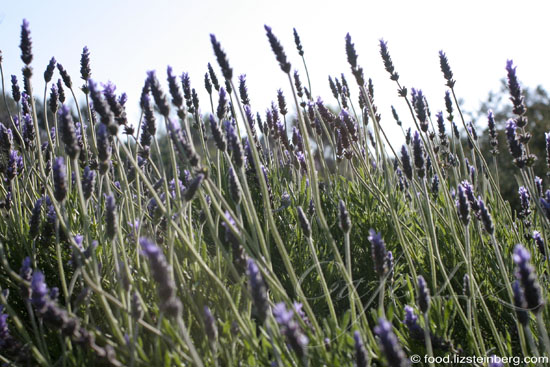
Lavender in the fields next to the Tzuk goat farm.
Visiting businesses participating in the Mateh Yehuda festival:
The festival is for the full month of March, and while most of the businesses probably accept guests year round, some — such as the people offering home hospitality — are probably better set up to do so during the festival. Most businesses are open on weekends, particularly Friday mornings and early afternoons.
The festival coordinators are offering an organized tour of several participating establishments on every Friday this month (departing from Beit Shemesh, 02-990-0903 to book). Alternately if you have a car, you can pick things that interest you from the festival pamphlet, or follow our itinerary marked on the map below. CALL EACH ESTABLISHMENT IN ADVANCE TO CONFIRM — even if the booklet gives the impression that this is a business with set operating hours. Many of the places are in private homes, and are generally hard to find without specific directions from the owners.
For more information on events and participants: Visit the festival’s Facebook page and click the image to download the brochure (Hebrew only). The brochure contains a list of participating establishments as well as information on organized tours and events. The same information is also available on the festival’s website.
View Mateh Yehuda food festival in a larger map

